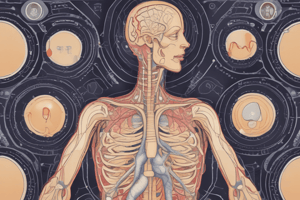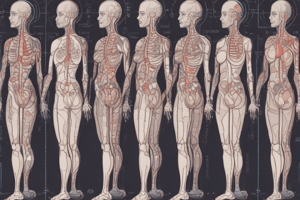Podcast
Questions and Answers
What is the primary function of parathyroid hormone (PTH)?
What is the primary function of parathyroid hormone (PTH)?
- Regulates blood glucose levels
- Stimulates the fight or flight response
- Promotes sleep-wake cycles
- Maintains calcium homeostasis (correct)
Which hormone is primarily responsible for increasing blood glucose levels during stress?
Which hormone is primarily responsible for increasing blood glucose levels during stress?
- Cortisol (correct)
- Glucagon
- Insulin
- Aldosterone
What condition is characterized by weak bones and kidney stones due to excess hormone secretion?
What condition is characterized by weak bones and kidney stones due to excess hormone secretion?
- Hypoparathyroidism
- Addison's disease
- Hyperparathyroidism (correct)
- Cushing's syndrome
Which of the following hormones is secreted by the adrenal medulla for a short-term stress response?
Which of the following hormones is secreted by the adrenal medulla for a short-term stress response?
What is the primary cause of Type 1 Diabetes Mellitus?
What is the primary cause of Type 1 Diabetes Mellitus?
What is one of the key functions of the endocrine system?
What is one of the key functions of the endocrine system?
Which of the following hormones is produced in the posterior pituitary?
Which of the following hormones is produced in the posterior pituitary?
What distinguishes steroid hormones from amino acid-based hormones?
What distinguishes steroid hormones from amino acid-based hormones?
Which gland is known as a neuroendocrine organ?
Which gland is known as a neuroendocrine organ?
What condition results from hypersecretion of Antidiuretic Hormone (ADH)?
What condition results from hypersecretion of Antidiuretic Hormone (ADH)?
Which hormone is primarily responsible for stimulating growth through IGFs?
Which hormone is primarily responsible for stimulating growth through IGFs?
What is the result of hyposecretion of Thyroid Hormone in adults?
What is the result of hyposecretion of Thyroid Hormone in adults?
Which of the following is NOT a method for hormone release regulation?
Which of the following is NOT a method for hormone release regulation?
Flashcards
Endocrine System
Endocrine System
System that controls and regulates body functions using hormones.
Hormones
Hormones
Chemical messengers transported in blood, affecting target cells.
Target Cells
Target Cells
Cells with specific receptors for specific hormones.
Oxytocin
Oxytocin
Signup and view all the flashcards
ADH (Antidiuretic Hormone)
ADH (Antidiuretic Hormone)
Signup and view all the flashcards
Growth Hormone (GH)
Growth Hormone (GH)
Signup and view all the flashcards
Thyroid Hormone (TH)
Thyroid Hormone (TH)
Signup and view all the flashcards
Diabetes Insipidus
Diabetes Insipidus
Signup and view all the flashcards
Hyperparathyroidism
Hyperparathyroidism
Signup and view all the flashcards
Addison's Disease
Addison's Disease
Signup and view all the flashcards
Diabetes Mellitus Type 1
Diabetes Mellitus Type 1
Signup and view all the flashcards
Glucagon
Glucagon
Signup and view all the flashcards
Cortisol
Cortisol
Signup and view all the flashcards
Study Notes
Endocrine System Overview
- Works with the nervous system to control and regulate bodily functions.
- Influences metabolic activities via hormones, transported through the bloodstream.
- Key functions include reproduction, growth and development, homeostasis maintenance (electrolyte, water, and nutrient balance), metabolism and energy regulation, and mobilization of body defenses.
Endocrine Glands
- Endocrine glands lack ducts, releasing hormones directly into surrounding tissues.
- Examples include: pituitary, thyroid, parathyroid, adrenal, and pineal glands.
- Hypothalamus is a neuroendocrine organ, with both neural and hormonal functions.
- Other organs with endocrine tissues include pancreas, gonads, placenta, adipose cells, thymus, stomach, kidneys, and heart.
Hormones
- Types of hormones:
- Amino acid-based hormones (peptides and proteins): water-soluble.
- Steroid hormones: lipid-soluble, synthesized from cholesterol.
- Eicosanoids: paracrines (acting locally).
- Hormones act on specific target cells possessing receptors.
- Actions on Target Cells:
- Alter plasma membrane permeability.
- Stimulate protein/enzyme synthesis.
- Activate/deactivate enzymes.
- Induce secretory activity.
- Stimulate mitosis.
Hormone Regulation and Secretion
- Stimuli for Hormone Release:
- Humoral: Response to blood levels of ions/nutrients.
- Neural: Nerve fibers stimulate hormone release.
- Hormonal: Hormones stimulate the release of other hormones.
- Nervous system can override normal endocrine controls (e.g., stress).
Key Hormones and Their Functions
Pituitary Gland
- Posterior Pituitary:
- Oxytocin: Uterine contractions, milk ejection.
- ADH (Antidiuretic Hormone): Water retention, increases blood volume.
- ADH Imbalances:
- Hyposecretion: Diabetes insipidus.
- Hypersecretion: Syndrome of Inappropriate ADH secretion (SIADH).
- Anterior Pituitary:
- GH (Growth Hormone): Stimulates growth via IGFs.
- Hypersecretion: Gigantism (children), acromegaly (adults).
- Hyposecretion: Pituitary dwarfism.
- TSH (Thyroid-Stimulating Hormone): Stimulates thyroid hormone release.
- ACTH (Adrenocorticotropic Hormone): Stimulates cortisol release.
- FSH & LH: Regulate gonadal hormone production.
- PRL (Prolactin): Stimulates milk production.
- GH (Growth Hormone): Stimulates growth via IGFs.
Thyroid and Parathyroid Glands
- Thyroid Hormone (TH):
- Increases basal metabolic rate and heat production.
- Regulates tissue growth and development.
- Imbalances:
- Hyposecretion: Myxedema (adults), goiter (iodine deficiency).
- Hypersecretion: Graves’ disease (autoimmune).
- Parathyroid Hormone (PTH): Maintains calcium homeostasis.
- Imbalances:
- Hyperparathyroidism: Weak bones, kidney stones.
- Hypoparathyroidism: Tetany, respiratory paralysis.
- Imbalances:
Adrenal Glands
- Adrenal Cortex:
- Mineralocorticoids (e.g., Aldosterone): Regulates Na+ and K+ balance.
- Glucocorticoids (e.g., Cortisol): Increases blood glucose, stress response.
- Hypersecretion: Cushing’s syndrome.
- Hyposecretion: Addison’s disease.
- Gonadocorticoids: Weak androgens; converted to testosterone or estrogens.
- Hypersecretion: Adrenogenital syndrome (masculinization).
- Adrenal Medulla: Produces catecholamines (epinephrine and norepinephrine). Short-term stress response (fight-or-flight).
Pineal Gland
- Secretes Melatonin: Regulates sleep-wake cycles.
Pancreas
- Glucagon: Raises blood glucose levels.
- Insulin: Lowers blood glucose levels.
- Diabetes Mellitus:
- Type 1: Hyposecretion of insulin.
- Type 2: Insulin resistance.
Other Hormones
- Gonads: Produce sex hormones (estrogen, progesterone, testosterone).
- Placenta: Temporary endocrine organ during pregnancy.
- Other Organs:
- Heart: ANP (reduces blood pressure).
- Kidneys: Erythropoietin (RBC production), Renin (blood pressure regulation).
Clinical Insights
- Hormone imbalances significantly affect metabolism, growth, and homeostasis.
- Environmental pollutants can disrupt hormone function.
Studying That Suits You
Use AI to generate personalized quizzes and flashcards to suit your learning preferences.




